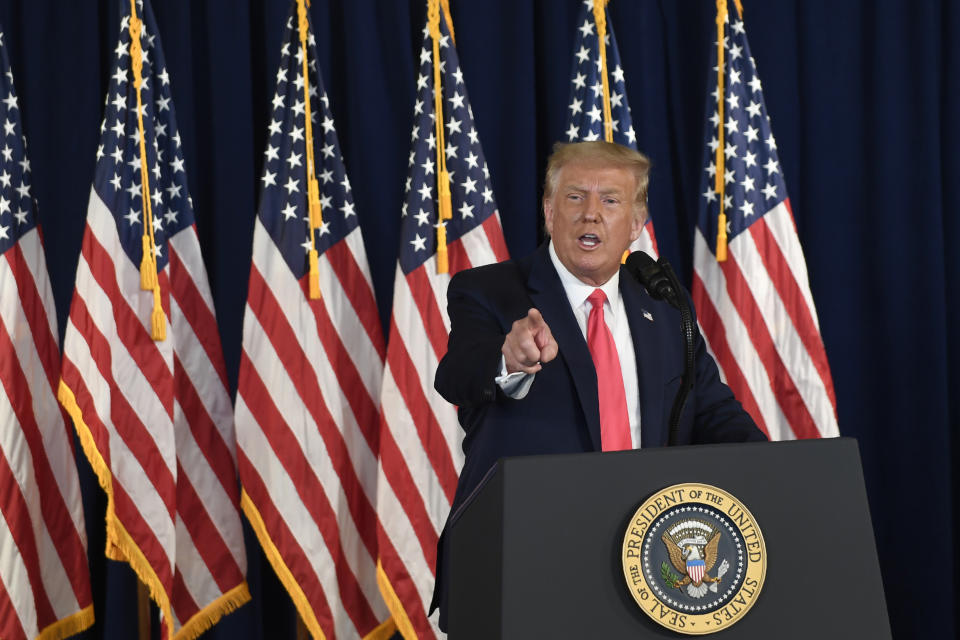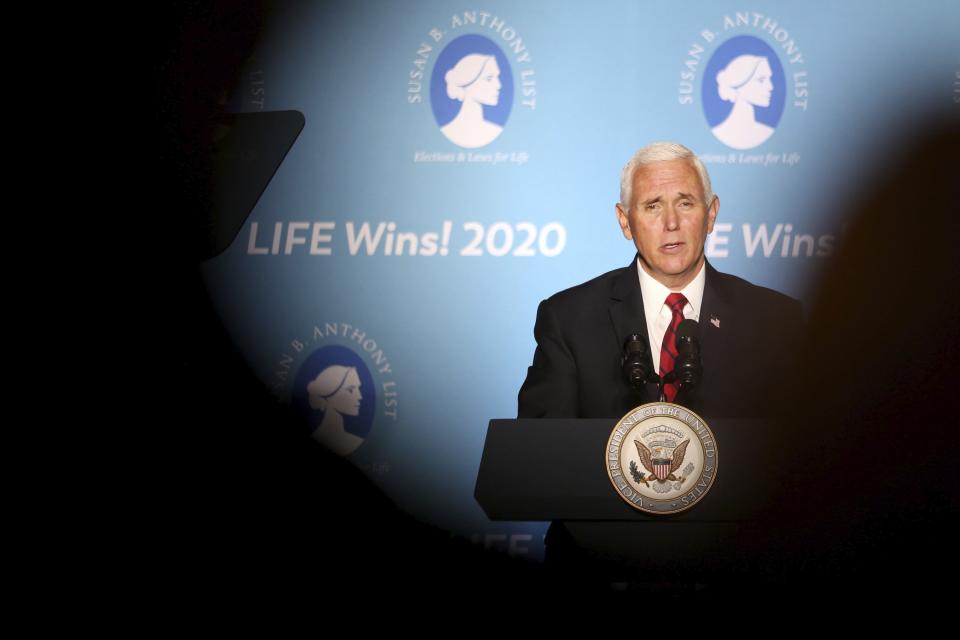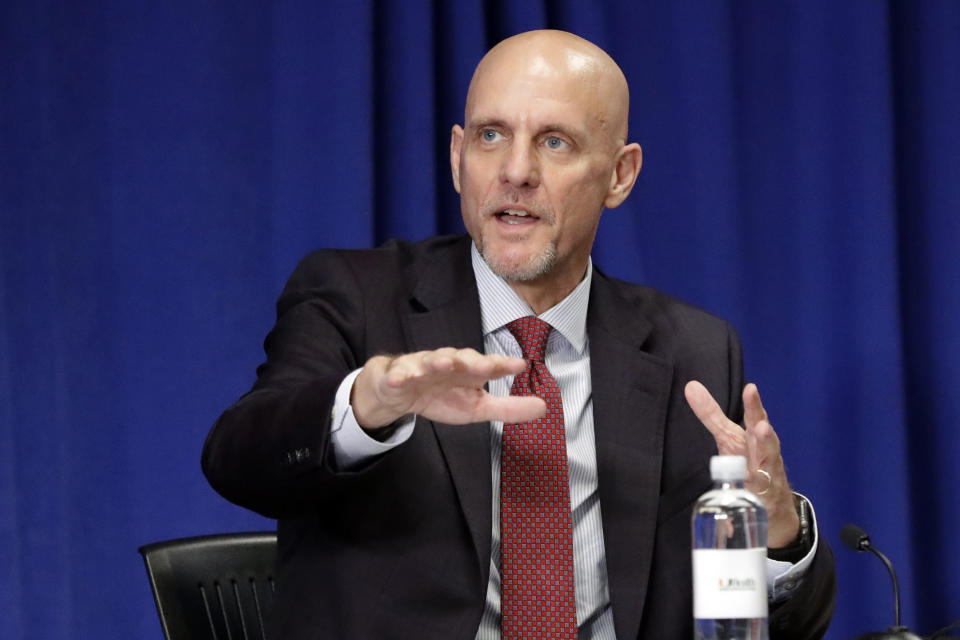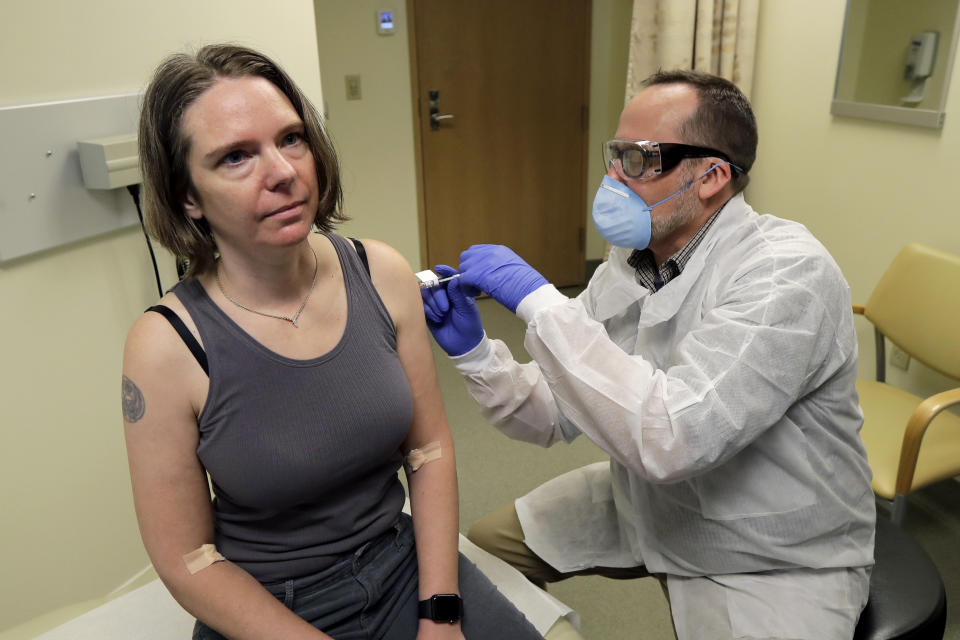AP FACT CHECK: Trump's smoke and mirrors on executive orders
WASHINGTON (AP) — President Donald Trump isn't telling the full story when it comes to executive orders on coronavirus relief payments and health care.
Over the weekend, the president suggested that his move to bypass Congress with executive action calling for up to $400 in weekly unemployment assistance would mean immediate cash in hand for laid-off Americans during the pandemic. There's no guarantee of that. His own economic adviser acknowledged Sunday that various details remained to be worked out, including contributions from the states, and that legal challenges appeared likely.
And on health care, Trump said he would pursue a “major” executive order to require health insurance companies to cover preexisting conditions, something that “has never been done before.” Actually, it's been done before — with “Obamacare,” a law that Trump is seeking to invalidate.
The claims came in a week where truth took a beating, on topics from mail-in voting to the virus threat.
A look at the claims and reality:
EXECUTIVE ORDERS
TRUMP, on how quickly laid-off U.S. workers would get up to $400 a week bonus payments under his executive order: “It will be rapidly distributed. ... They’re going to see it very soon.” — news conference Saturday.
THE FACTS: An imminent payment is unlikely, if one comes at all.
It is an open question how many people will receive the $400 weekly benefit, which is one-third less than the $600 previously provided by the federal government, and how long it might take to arrive. Trump’s executive order seems to leave it up to the states to decide whether to participate and also asks them to cover 25%, or $100, of the cost, a major hurdle when their budgets are already under severe strain.
White House economic adviser Larry Kudlow on Sunday insisted the first checks could come “in a couple of weeks,” but acknowledged that the administration had yet to fully canvass the states to see if they would be able to afford their payment share. Kudlow also allowed that the executive action could wind up in court. Several lawmakers have questioned the legality of the orders, which bypass legislation that would need to be approved by Congress. On Saturday, Sen. Ben Sasse, R-Neb., called the theory behind the executive orders “unconstitutional slop.”
“We think we can do it,” Kudlow told ABC’s “This Week.”
But there was a new wrinkle Sunday night: Trump told reporters that states could apply for federal dollars covering all or part of the $400 payments. He said decisions would be made on a state-by-state basis.
The previous supplemental unemployment benefit of $600 per week expired at the end of July.
___
TRUMP, on whether he was expecting legal challenges to his orders: “I didn’t say that. No, no. I didn’t say that.” — news conference Saturday.
THE FACTS: He did say it.
At his news conference a day earlier in Bedminster, New Jersey, Trump said: “Yeah, probably we get sued, but people feel that we can do it.”
___
TRUMP: “Over the next two weeks, I’ll be pursuing a major executive order requiring health insurance companies to cover all preexisting conditions for all customers. That’s a big thing. ... This has never been done before.” — news conference Friday.
THE FACTS: No executive order is needed to protect people with preexisting medical conditions because “Obamacare” already does that and it’s the law of the land. If Trump persuades the Supreme Court to overturn the Affordable Care Act as unconstitutional, it’s unclear what degree of protection an executive order would offer in place of the law.
The Obama health law states that “a group health plan and a health insurance issuer offering group or individual health insurance coverage may not impose any preexisting condition exclusion with respect to such plan or coverage.”
Other sections of the law act to bar insurers from charging more to people because of past medical problems and from canceling coverage, except in cases of fraud. In the past, there were horror stories of insurers canceling coverage because a patient had a recurrence of cancer.
It’s dubious that any president could enact such protections through an executive order, or Obama would never have needed to go to Congress to get his health law passed. Likewise, President Bill Clinton could have simply used a presidential decree to enact his health plan, or major parts of it, after it failed to get through Congress.
Republicans were unable to muscle their replacement through Congress when they controlled the House and Senate in 2017 during Trump’s first year. Various GOP bills would have offered a degree of protection for people with preexisting conditions, but the proposed safeguards were seen as less than what the law already provided. The general approach in the Republican legislation would have required people to maintain continuous coverage to avoid being turned down because of a preexisting condition.
___
VETERANS
TRUMP: “Our vets are very special. We passed Choice, as you know — Veterans Choice ... And they’ve been trying to get that passed for decades and decades and decades, and no president has ever been able to do it. And we got it done.” — news conference Saturday.
THE FACTS: This is one of Trump’s most frequent falsehoods. He’s incorrect that he achieved Veterans Choice when other presidents couldn’t. President Barack Obama achieved it in 2014. Trump expanded it.
The program allows veterans to see a private doctor for primary or mental health care at public expense if their VA wait is 20 days (28 for specialty care) or their drive to a VA facility is 30 minutes or more.
___
FOREIGN INTERFERENCE
TRUMP, on the threat from Russia, China and Iran of meddling in the U.S. presidential election: “The biggest risk that we have is mail-in ballots. ... It’s much easier for them to forge ballots and send them in, it’s much easier for them to cheat with universal mail-in ballots.” — news briefing Friday.
THE FACTS: Mail-in ballots aren’t the biggest risk for foreign interference.
Trying to influence a federal election through mail-in ballots would probably mean paying thousands of U.S. citizens, carefully selected in pivotal states, who are willing to conspire with a foreign government and risk detection and prosecution.
Far easier and cheaper would be a social media campaign seeking to discourage certain groups of people from voting, which is something the FBI has warned about. Or a cyberattack on voter registration data that would eliminate certain voters from the rolls. That could cause havoc at polling places or election offices as officials attempt to count ballots from people who are “missing” from their voter databases.
On Friday, William Evanina, director of the National Counterintelligence and Security Center, warned about foreign interference and said Russia was already trying to undercut Democratic candidate Joe Biden. Evanina cited in part Kremlin-linked figures who are “seeking to boost President Trump’s candidacy on social media and Russian television.”
Last month, Attorney General Bill Barr raised the possibility that a “foreign country could print up tens of thousands of counterfeit ballots.” He argued they would be hard to detect, but that’s been disputed by election experts.
Absentee and mail-in ballots are printed on special paper and must be formatted correctly in order to be processed and counted. Ballots are specific to each precinct, often with a long list of local races, and would be identified as fraudulent if everything didn’t match precisely.
___
VOTING FRAUD
TRUMP: “You look at some of the corruption having to do with universal mail-in voting. Absentee voting is OK.” — Axios interview released Monday.
VICE PRESIDENT MIKE PENCE: “Absentee balloting is perfectly acceptable. You have to apply for an absentee ballot, signatures are checked, it’s confirmed, it is a long tradition. ... But this universal mail in voting where you’re going to see literally ballots showered all across the state -- it is ripe for fraud.” — Fox News interview on Aug. 3.
THE FACTS: Trump and his vice president are making a false distinction. Mail-in ballots are cast in the same way as absentee mail ballots, with the same level of scrutiny such as signature verification in many states.
In more than 30 states and the District of Columbia, voters have a right to “no excuse” absentee voting. That means they can use mail-in ballots for any reason, regardless a person is out of town or working. In Florida, the Legislature in 2016 voted to change the wording of such balloting from “absentee” to “vote-by-mail” to make clear a voter can cast such ballots if they wish.
More broadly, voter fraud has proved exceedingly rare. The Brennan Center for Justice in 2017 ranked the risk of ballot fraud at 0.00004% to 0.0009%, based on studies of past elections.
Five states relied on mail-in ballots even before the coronavirus pandemic raised concerns about voting in person.
“Trump is simply wrong about mail-in balloting raising a ‘tremendous’ potential for fraud,” Richard L. Hasen, an elections expert at the University of California, Irvine, School of Law, wrote recently. “While certain pockets of the country have seen their share of absentee-ballot scandals, problems are extremely rare in the five states that rely primarily on vote-by-mail, including the heavily Republican state of Utah.”
In an apparent turnabout, Trump later in the week urged voters in Florida to vote by mail despite his rhetoric against the practice, arguing in a tweet that its system is “safe and secure, tried and true.” Florida is a must-win state for Trump, where Democratic requests to vote by mail have been surging higher.
___
STEPHEN MILLER, White House senior adviser: “Here’s a shocking thing for your audience to consider. Nobody who mails in a ballot has their identity confirmed. Nobody checks to see if they’re even a U.S. citizen. Think about that. Any — any foreign national, talk about foreign election interference, can mail in a ballot and nobody even verifies if they’re a citizen of the United States of America.” — Fox News interview on Aug. 3.
THE FACTS: He’s incorrect to assert that measures aren’t in place to confirm a voter’s identity or prevent fraud with mail ballots.
Ballots typically require voters to provide identifying information such as a birth date or Social Security or driver's license number. In most states, voters also sign the back of the envelope, which is then verified with the signature on their voter registrations.
Many jurisdictions use a bar code on the envelope, which is used to help states identify any duplicate ballots and also let voters know if their ballot was received.
Miller ignores separate built-in safeguards for mail-in ballots. The ballots, for instance, are generally sent to registered voters, who have to provide identifying information at the time of registration, such as an address, birth date and proof of citizenship.
In Miller’s hypothetical scenario of a foreign national improperly casting a vote, that ballot would be flagged and rejected for not having a signature on file or for failing to match one that is. Based on the envelope’s bar code, state voting officials also could identify and eliminate any duplicate ballots, whether they were submitted mistakenly or fraudulently.
___
NEVADA VOTING
TRUMP, on mail ballots: “There’s no verification of signatures. So they don’t even know who’s going to sign this. They have literally a clause that you don’t have to verify the signatures — that they don’t have to do it.” — remarks Wednesday.
THE FACTS: Not true. Nevada’s existing law requires signature checks on mail ballots. A new law also spells out a process by which election officials are to check a signature against the one in government records.
In Nevada’s June primary, nearly 7,000 ballots were thrown out due to mismatched or missing signatures.
___
MERCEDES SCHLAPP, Trump campaign senior adviser: “Even come Election Day, you could still cast a ballot three days later if you don’t have a postmark, or seven days later if you have a postmark. ... Say you vote for Joe Biden, then you find out in Nevada that President Trump wins. You can go to your family members, you can go to your colleagues and say, ’Guess what, do you still have that mail-in vote? Let’s cast it, because you can cast it several days after the election.” — CNN interview Tuesday.
THE FACTS: It’s a distortion for her to assert that Nevada voters could still cast ballots several days after the election.
Under the new law, ballots must be postmarked or “cast” by Election Day to be counted. Election officials are given up to seven days to receive and count those ballots after the election. That additional time for receipt is routine practice in many states for overseas and military voters who submit ballots by mail.
Separately, the law states that if a mail ballot is received up to three days after the election, it can be counted if the date of the postmark is unclear or missing. The aim is to provide enough time for delivery and processing of ballots that are properly mailed on Election Day, though the Trump campaign alleges in a lawsuit filed this past week that the three-day provision would allow some ballots to be improperly mailed after the election and then counted.
That scenario is not the same as granting wide license to cast ballots “several days” after the election, as Schlapp asserts.
The campaign's suit acknowledges that the window for alleged mischief is small because most mail in Nevada already takes at least one or two days to arrive. Some of those ballots may display postmarks showing they were sent late, which would disqualify them.
___
TRUMP: “What they’re going to do is blanket the state, anybody that ever walked, frankly, will get one.” — Fox News interview Wednesday.
THE FACTS: His imagery of any living being in Nevada receiving a mail-in ballot, regardless of age or other eligibility factors, is false.
The new law requires that ballots be sent to “active” registered voters. “Active” registered voters are generally those with a current address on file with their local elections office.
There are additional requirements to be registered to vote. In Nevada, a person must be a U.S. citizen and resident of the state, at least 18 years old, not currently in state or federal prison, and not found to be mentally incompetent to vote by a court.
___
NEW YORK VOTING
TRUMP, on two Democratic congressional primaries: “They don’t know what happened to them, is there fraud, is there -- it’s a disaster.” — news briefing Tuesday.
THE FACTS: While there were vote-counting delays, there’s no evidence of fraud in the two Democratic congressional primaries in New York City that Trump refers to, which were won by city council member Ritchie Torres and Rep. Carolyn Maloney. Nor did Trump offer any proof of fraud.
New York state decided to allow anyone to vote by mail in the June primary because of the coronavirus pandemic. More than 400,000 people voted by absentee ballot in New York City, a figure that was 10 times the number of absentee ballots cast in the 2016 primary.
Opening and counting those ballots by elections officials took weeks. New York City’s Board of Elections ultimately certified the results six weeks after the election.
___
CORONAVIRUS
TRUMP, asked if a vaccine for COVID-19 could become available before the election: “I think in some cases, yes possible before, but right around that time. ...I’m rushing it. I am. I’m pushing everybody.” — interview Thursday on the Geraldo Rivera radio program.
THE FACTS: He’s offering a more ambitious timeline than his health experts and omitting key facts.
Dr. Anthony Fauci, the government’s top infectious diseases expert, has said he is “cautiously optimistic” that a coronavirus vaccine will be ready by early next year. Even then, Fauci made clear that the vaccine would not be widely available right away.
“Ultimately, within a reasonable period of time, the plans now allow for any American who needs a vaccine to get it within the year 2021,” Fauci told Congress last month.
Under White House orders, federal health agencies and the Defense Department are carrying out a plan to deliver 300 million vaccine doses on a compressed timeline. That will happen only after the Food and Drug Administration determines that one or more vaccines are safe and effective. Several candidates are being tested.
The push for a speedy vaccine has drawn concern from some scientists that the White House will pressure U.S. regulators to approve a vaccine before it’s ready.
In an op-ed this past week, FDA Commissioner Dr. Stephen Hahn said his agency will not be influenced by any political pressure and will make decisions “based solely on good science and data.”
___
TRUMP: “Children are almost — and I would almost say definitely — but almost immune from this disease, so few. ...They don’t have a problem, they just don’t have a problem. ... And I’ve have watched some doctors say they’re totally immune.” — Fox news interview Wednesday.
THE FACTS: They aren’t immune. Although it’s true that children are less likely than adults to develop COVID-19, the Centers for Disease Control and Prevention has nevertheless counted more than 250,000 infections by the virus in Americans younger than 18, or roughly 7% of all cases.
The number of kids who have been infected but not confirmed is almost certainly far higher than that, experts say, because those with mild or no symptoms are less likely to get tested.
Trump overlooks severe COVID-19 illnesses and some deaths of children in the U.S., even though kids in general tend to get less sick from it than adults do. He also glosses over the fact that kids can spread disease without showing symptoms themselves.
The CDC in April studied the pandemic’s effect on different ages in the U.S. and reviewed preliminary research in China, where the coronavirus started. It said social distancing is important for children, too, for their own safety and that of others.
“Whereas most COVID-19 cases in children are not severe, serious COVID-19 illness resulting in hospitalization still occurs in this age group,” the CDC study says.
The CDC in May also warned doctors to be on the lookout for a rare but life-threatening inflammatory reaction in some children who’ve had the coronavirus. The condition had been reported in more than 100 children in New York, and in some kids in several other states and in Europe, with some deaths.
Trump's claim prompted Facebook to delete his post with a link to the Fox News video because of the misinformation. Twitter temporarily blocked the Trump campaign from tweeting from its account, until it removed a post with the same video.
___
AP’s Election Research and Quality Control Group in New York, and Associated Press writers Nicholas Riccardi in Denver, Michelle L. Price in Las Vegas, Sam Metz in Carson City, Nevada, and Ricardo Alonso-Zaldivar, Lauran Neergaard, Zeke Miller and Darlene Superville in Washington contributed to this report.
___
EDITOR'S NOTE — A look at the veracity of claims by political figures.
___
Find AP Fact Checks at http://apnews.com/APFactCheck
Follow @APFactCheck on Twitter: https://twitter.com/APFactCheck







